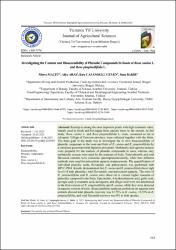| dc.contributor.author | Macit, Merve | |
| dc.contributor.author | Aras, Aliye | |
| dc.contributor.author | Çapanoğlu Güven, Esra | |
| dc.contributor.author | Bakır, Sena | |
| dc.date.accessioned | 2023-09-26T06:23:46Z | |
| dc.date.available | 2023-09-26T06:23:46Z | |
| dc.date.issued | 2023 | en_US |
| dc.identifier.citation | Macit, M., Aras, A., Çapanoğlu Güven, E. & Bakır, S. (2023). Investigating the Content and Bioaccessibility of Phenolic Compounds In Roots of Rosa canina L. and Rosa pimpinellifolia L.. Yuzuncu Yil University Journal of Agricultural Sciences, 33(2), 163-173. https://doi.org/10.29133/yyutbd.1231881 | en_US |
| dc.identifier.issn | 1308-7576 | |
| dc.identifier.uri | https://doi.org/10.29133/yyutbd.1231881 | |
| dc.identifier.uri | https://hdl.handle.net/11436/8379 | |
| dc.description.abstract | Rosehip is among the most important plants with high economic value, mainly used in foods and beverages from ancient times to the present. In this study, Rosa canina L. and Rosa pimpinellifolia L. roots, consumed as tea in Aktoprak Village of Erzurum province, were collected together with the fruits. The main goal of the study was to investigate the in vitro bioaccessibility of phenolic compounds in the roots and fruits of R. canina and R. pimpinellifolia by a simulated gastrointestinal digestion procedure. Methanolic and aqueous extracts were prepared for the analysis of phenolic compounds in roots, whereas only methanolic extracts were used for the analyses of fruits. Total phenolic and total flavonoid contents were evaluated spectrophotometrically, while four different methods were used for antioxidant capacity measurements. The quantification of individual phenolic acids, flavonoids, and anthocyanins was performed with HPLC-PDA. Results demonstrated that R. canina and R. pimpinellifolia have high levels of total phenolics, total flavonoids, and antioxidant capacity. The roots of R. pimpinellifolia and R. canina were observed to contain higher amounts of phenolics compared to the fruits. Epicatechin, 4-hydroxybenzoic acid, gallic acid, syringic acid, p-coumaric acid, naringenin, and ellagic acid were not determined in the fruit extracts of R. pimpinellifolia and R. canina, while they were detected in aqueous extracts of roots. Bioaccessibility analyses carried out on aqueous root extracts showed total phenolic recovery was 12.73% in R. canina, 10.71% in R. pimpinellifolia, and total flavonoid recovery was 0% in both species. | en_US |
| dc.language.iso | eng | en_US |
| dc.publisher | Van Yüzüncü Yıl Üniversitesi | en_US |
| dc.rights | info:eu-repo/semantics/openAccess | en_US |
| dc.subject | Bioaccesibility | en_US |
| dc.subject | Phenolic compounds | en_US |
| dc.subject | Root | en_US |
| dc.subject | Rosa canina L. | en_US |
| dc.subject | Rosa pimpinellifolia L. | en_US |
| dc.title | Investigating the content and bioaccessibility of phenolic compounds in roots of Rosa canina L. and Rosa pimpinellifolia L. | en_US |
| dc.type | article | en_US |
| dc.contributor.department | RTEÜ, Ardeşen Turizm Fakültesi, Gastronomi ve Mutfak Sanatları Bölümü | en_US |
| dc.contributor.institutionauthor | Bakır, Sena | |
| dc.identifier.doi | 10.29133/yyutbd.1231881 | en_US |
| dc.identifier.volume | 33 | en_US |
| dc.identifier.issue | 2 | en_US |
| dc.identifier.startpage | 163 | en_US |
| dc.identifier.endpage | 173 | en_US |
| dc.relation.journal | Yuzuncu Yil University Journal of Agricultural Sciences | en_US |
| dc.relation.publicationcategory | Makale - Uluslararası Hakemli Dergi - Kurum Öğretim Elemanı | en_US |


















